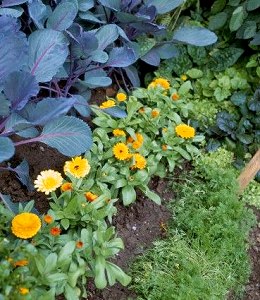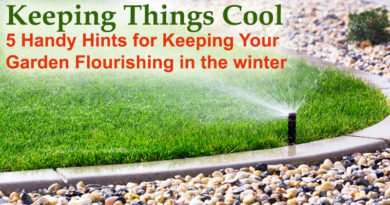Grow Flowers With Vegetables: How to Optimize Your Rows
 The first thing to do when considering starting a garden, is planning it. Mainly consisting of what you plan to grow this year, and in what area. It is also important to master the art of companion gardening and learn to grow flowers with vegetables.
The first thing to do when considering starting a garden, is planning it. Mainly consisting of what you plan to grow this year, and in what area. It is also important to master the art of companion gardening and learn to grow flowers with vegetables.
Many people decide to either do flowers, or vegetables. A separate plot for each, with veggies in one plot, flowers in another, and possibly a plot for herbs as well. This is a great way to do things, and does achieve results. However, there is a better way, that may seem a little more unorganised, but brings a more successful and healthy garden to life. This is called “Companion Gardening.” Planting your herbs, flowers, and vegetables together, instead of separately. Many beginner gardeners also don’t realize how beneficial to your vegetable and herbs Companion Gardening is; many flowers keep away pests, and worms.
Companion Herbs
Before we go on to how beneficial flowers are to your vegetable garden, also realize that co-mingling herbs with some vegetables is also very beneficial. Thyme deters cabbage worms, and can be planted here and there, in different areas of your plot. Valerian is also good to plant all over the garden, and has many health benefits. Summer savory, known for being an excellent addition to poultry dishes especially, can be planted near beans and onions, as it deters bean beetles. Sage can be planted near Rosemary, and protects your carrots, cabbage, peas, beans from many pests. On the other hand, Rosemary is planted near all the same vegetables, and wards off carrot flies, bean beetles and cabbage moths. Parsley can be planted near or around tomatoes and asparagus. Mint can also be planted near tomatoes, or any of the cabbage family vegetables, and keeps away cabbage moths as well. Marjoram and lemon balm can be planted throughout your garden, anywhere.

Herbs to be Kept Away
Other herbs can be great for steering away pests, but you have to keep them away from other vegetables, such as Hyssop. It can be planted near grapes, and cabbages to keep the moths out, but should never be planted near radishes. Chervil on the other hand is excellent to plant near radishes; it promotes both growth, and good health. Lamb’s Quarters are an edible and nutritious weed that can be grown with corn without causing any fuss. Fennel is better grown in a pot, away from other plants and vegetables, as it is shown that most plants dislike it. Garlic however, is excellent to plant all over the garden to deter creepy crawlers, as well as enhancing the flavour of herbs, defending plants against the large Japanese beetles. It’s also beneficial to roses and raspberries.
More Garden Companions
Flax is excellent to plant near carrots and potatoes. Dill promotes excellent growth and health of cabbage; another must have herb to grow if you plan on a cabbage patch. Chives mingle well with carrots, and if you plant plenty of chives around the base of fruit trees, it discourages insects to climb the trunk. Catnip is good for planting in the borders of your garden; it warns away flea beetles. Caraway loosens soil to promote good growth for the roots of all your plants, so it can be planted here and there throughout your garden. Basil and Rue shouldn’t be mixed, however, Basil planted near tomatoes promotes good flavour and growth, while also protecting against flies and mosquitoes. Chamomile is good for cabbage, as well as onions.
Grow Flowers with Vegetables

Flowers that can be mingled into your vegetable garden are excellent for reasons aside from being just helpful to plants and veggies; they’re also bright, colourful, and attractive. Yarrow, is a very vivid flowering plant to include in your garden, along paths or borders. Planting Yarrow near herbs makes essential oils increase, which cause the herbs to be more flavourful. Tansy is another surprisingly useful, and beautiful flower. Many are surprised at how many different pests it deters because tansy looks so delicate. Don’t be fooled; tansy deters flying insects, Japanese beetles, striped cucumber beetles, squash bugs, and even ants. It’s ideal for planting under fruit trees. Sunflower is a great and beneficial addition to cucumbers. Your average marigold is also beneficial, as many experienced gardeners know, to keep pests from tomatoes; however, planting them throughout your garden will keep pests away from other plants as well, not to mention add colour to more than one area. Petunias are also beneficial all over a garden, and particularly protect beans. Nasturtiums keep away aphids, a major pest, that preys off of flowers and weakens stems. Dead Nettle is another plant to have in your garden, especially if you’re planning potatoes this spring; dead nettle keeps potato bugs away.
The combinations you can make with vegetables as well, to protect each other are nearly endless, and great for people with limited space. For more detailed information on organic gardening, or companion gardening, look through your local bookstore for beginners gardening books. One book that’s excellent for new learners is ‘Carrots Love Tomatoes‘ by Louise Riotte.


